Last year, fruited sours landed on the list of Untappd’s top most checked-in styles of the year with just over three million check-ins. It was the only “non-IPA” category to even crack the top five.
This ranking is just one of many showing that consumers are in a fervor for fruit.
At Oregon Fruit Products, one of the largest suppliers of fresh aseptic fruit purees in the beer industry, the last six years have meant incredible growth for their fermentation industry sales. “In six years we have grown over fifty percent a year,” says Chris Hodge, director of sales at Oregon Fruit Products. “Every single year we’ve tripled the size of our fermentation category.”
So with aseptic fruit purees at their peak, understanding how to properly brew with them is essential. But, of course, there are almost an endless amount of considerations.
We spoke with Oregon Fruit Products to find out the best tips and tricks for working with fruit puree: the advantages, the cost, and their best practices.
(Above photo courtesy of Oregon Fruit Products)
What We’ll Cover in This Piece:
What Are the Advantages of Using Fruit Purees?
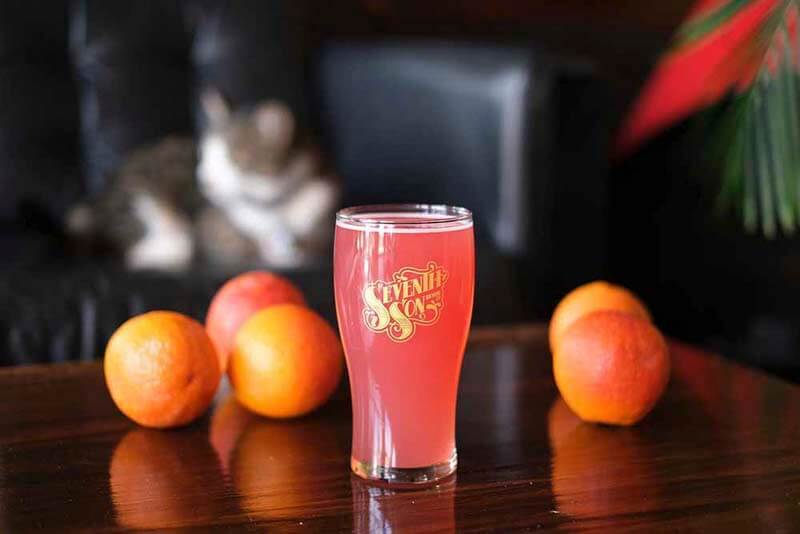
Photography courtesy of Seventh Son Brewery
Why even use a fruit puree in place of, say, the actual fruit itself, a juice, or even a natural flavoring? There are several standout reasons.
Remains the Safest to Use
Aseptic fruit purees, like those from Oregon Fruit Products, are proven safe because they are aseptically processed. This just means that the product has been cooked and commercially sterilized to be safe for consumption.
This also means these fruit purees are shelf stable with no refrigeration required for shipping or storing.
“It’s a tried and proven ingredient that has continued to shine above all the others in the field whether concentrate or other types of ingredients,” says Hodge, who has been in the beer business for almost thirty years. “The fact it is a puree is a very important piece of the puzzle for the craft brewing industry.”
Creates Better Taste and Flavor
Because you’re using one hundred percent real fruit, brewing with a fruit puree brings the true essence of that fruit’s flavor to your beer.
“There is really an added value in terms of the taste when using one hundred percent real fruit,” says Julia Smith, marketing manager at Oregon Fruit Products. “You can taste the difference when you’re using something that has a lot of additives. It is really separated from the real fruit character.”
At Trillium Brewing Company, Director of Quality and Innovation Burke Dingham says that you simply can’t replicate the flavor you get from a one hundred percent real fruit puree.
“You can’t imitate it,” he says. “Extracts, syrups, you can tell right away by smelling a beer whether it has been doctored up or isn’t using fresh fruit.”
Burke explains that real fruits are an amalgamation of a lot of different aroma compounds. “To boil that down into one or two compounds, you’re still missing ancillary compounds that make it identifiable as natural, fresh, whole fruit,” he says.
Which is one of the main reasons why Trillium uses aseptic fruit purees in its two extremely popular series: Daily Serving, a Berliner weisse base with a fruit puree addition, and Twice Daily Serving, which essentially has twice the amount of fruit.
According to Dingham, Trillium has close to fifty different versions of these beers with different combinations of fruit purees.
Better, truer flavor tends to attract more customers and sell more beer.
Attracts More Customers
Adding fruit to beer has been a helpful tool for brewers to attract a diversity of consumers.
“It became a way to bring different kinds of beer drinkers into their customer base for brewers,” says Smith. “It expanded the flavor, styles, and character you can get out of beer, which attracted a bunch of new people or people [who were] not traditional beer drinkers.”
Plus, the simple addition of real fruit appeals to a growing number of health-conscious consumers.
Smith says that the “fruit halo” consumers want with products that include real fruit makes a big difference when it comes to marketing your beverage. “People care if it’s made with real fruit and you can actually sell it for more.”
A recent Healthy Eating report from Technomic found that consumers are actively looking for labels with healthy ingredients, reporting that fifty-seven percent of participants say they perceive food and drinks labeled as “real” as healthier. As a brewer, using aseptic fruit puree allows you to use the words “real fruit” in your marketing and on your labels, potentially attracting a plethora of consumers hungry for products with real ingredients.
Cuts Down on Labor
This advantage applies directly over using whole fruit, which can involve a lot of labor and time-intensive processing. “You don’t have to cut a whole bunch of prickly pears yourself,” says Smith, who notes that Oregon Fruit Products introduced a prickly pear puree to their lineup after hearing about the difficulties brewers had processing this fruit. “Prickly pear wasn’t supplied out of thin air… We heard from brewers specifically that they were pulling spines out of their fingers as they were processing prickly pears.”
Using fruit purees is easier than processing whole fruit, cutting down on important time and labor costs.
The convenience of using fruit purees cannot be denied.
Provides a Consistent Product…Consistently
When it comes to real fruit there are a lot of variables to consider, including acidity, color, taste, and brix, a measure of the total soluble solids in a fruit.
“We get this question a lot from brewers: How does your Raspberry in February taste the same as your Raspberry in August after harvest?” says Hodge. The key is that Oregon Fruit Products has annual contracts with some of the largest fruit growers in the Northwest, plus a few overseas. Fruit gets blending until it hits very rigorous standards for brix, pH, pantone, and viscosity. “All four of those components really lend themselves well to having a high level of confidence at the end user,” says Hodge.
Having a stable, consistent product available is an undeniable advantage.
Additionally, being able to access this fruit year round is pivotal.
“Fruit purees give a better consistency and great availability throughout the year while producing more variety to you,” says Dingham. “In New England, we don’t have local access to pineapples, guava, passion fruit. Those are really popular fruits that taste incredible and we want to have that offering for customers and play with it.”
The Two Common Methods for Adding Fruit Puree to Your Beer
Much like dry hopping, every brewery will most likely have a method they like best for introducing a fruit puree into beer.
Hodge sees this as a positive. “I’ve hung out with hundreds of brewers and watched them talk about their best method, and the good news is there is no perfect method,” he says.
However, there are preferred methods and they fall into two categories: during primary fermentation or during post- or secondary fermentation.
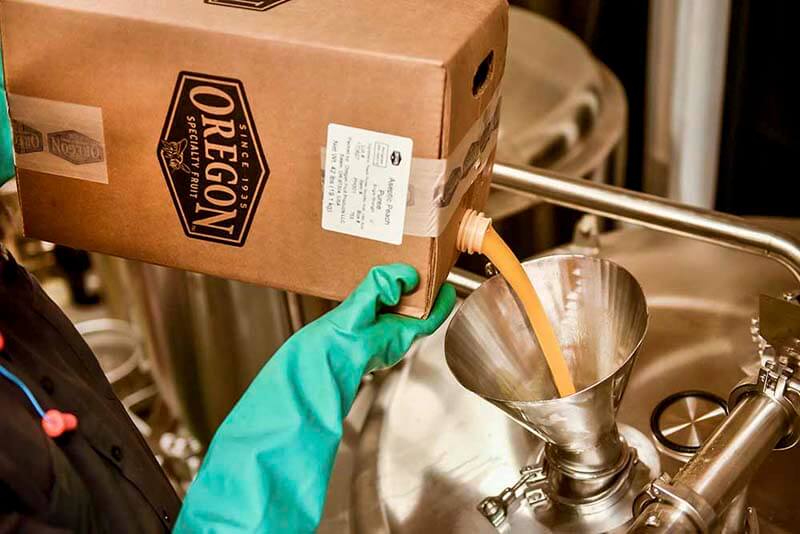
Photography courtesy of Oregon Fruit Products
During Primary Fermentation
This is the method Hodge says they recommend the most at Oregon Fruit Products. “Dosing during primary is the best method we believe for extracting color, maintaining color, extracting aromas, maintaining aromas, and also making sure a fair amount of the sugar (not all) gets fermented out,” he says.
Hodge suggests adding the fruit puree during day two or three of primary fermentation, “where you have a rolling ferment is best,” he says. “Let it sit in there with the beer through contact all the way through the cold crash and then filter out whatever drops down and let the rest remain in the beer.”
Likewise, Dingham suggests that if you add fruit puree during primary fermentation, do it right before crashing, “so that you retain as much character as you can with the finished product,” he says.
During Secondary Fermentation
A process seen more often nowadays to create these “smoothie-like” fruit beers, adding fruit puree during secondary fermentation delivers a bigger punch of thick fruit flavor without having to use as much puree.
So the real advantage here is saving the amount of puree you need to use.
But you need to be extremely careful with this method. Adding the fruit puree at this stage means your beer will retain a high amount of residual sweetness, keeping your product from being shelf stable.
Fierce Fruit, another fruit puree provider, in its article on the “7 Tips & Tricks for Brewing the Best Beer with Fruit Purees,” recommends if you’re adding fruit purees during secondary fermentation to leave them in the beer for about a week. This allows time for flavor to develop and as much as the sugars as possible to ferment.
If you’re looking for more of a strict calculation when it comes to adding in your fruit puree, Stein Servick, brewmaster at Napa Smith Brewery, in his article on Brewing with The Perfect Purée proposes the following:
“We suggest adding the puree 2-3 points from your terminal specific gravity. For example, if your expected terminal is 3.5° Plato (1.014), add the fruit puree when the beer reaches 5.5° – 6.5° Plato (1.022 – 1.026). This allows for fermentables to be consumed fully,” he says.
At Trillium, Dingham says they add the fruit after fully fermenting the beer. “We’ll crash the tank, add the fruit in, pumping that in and homogenizing the tank to disperse the fruit,”
According to Dingham, that’s key in order to distribute the fruit character across the entire beer.
After letting the fruit sit for about twenty-four hours, Burke says Trillium actually sends the beer through a centrifuge to remove gritty fruit particles along with a flash pasteurizer to quickly and gently heat it, “killing off any yeast we have leftover from primary fermentation that is not centrifuged out,” he says.
Just like the caution above, Dingham says that their process should only be followed if a brewery has a flash pasteurizer at their disposal. Otherwise, you’ll run into issues with extra fermentation in the can once the product has been packaged.
What Is the Right Amount of Fruit Puree to Use in Your Recipe?
Mostly, the answer to this question is subjective. What are your goals with the style of beer you’re trying to make? How much do you want the fruit to sing? Are you only featuring one fruit or multiple fruits?
When trying to figure out how much fruit to use, it often comes down to the fruit itself. “You can take a black currant or passion fruit and use a quarter pound [of puree] per finished gallon of beer, but you take a strawberry or blood orange and you need two pounds of puree per gallon of beer,” says Hodge. “It’s a broad range, it’s fruit specific, pH and brix specific, and brewer discretion specific.”
The two biggest pieces of advice Hodge can give here? Talk with an expert (like himself) to hash out what will work best based on what you’re aiming to achieve in the final beer.
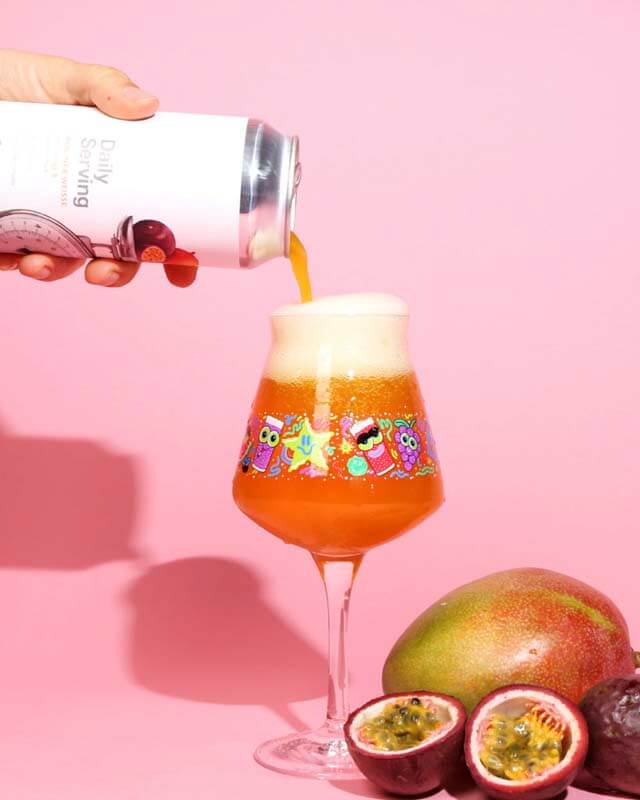
Photography courtesy of John A. Paradiso
“We love direct conversations because there is no perfect method of dosing,” he says.
Also, take advantage of free samples. “The smart ones reach out multiple times throughout the year, as they’re building a recipe, for free samples,” says Hodge.
He recommends dosing a finished beer with the fruit puree they’d like to use to test it out. “You have to do it fairly quickly with freshly poured beer,” he cautions. And make sure the dosing amount you use can mathematically scale up to a finished product.
At Trillium, Burke says they take full advantage of free samples and experiment with a lot of benchtop trials. “In the lab, we’ll take the base beer and dose in a certain rate of fruit,” he explains. “We’ll come together as a group and evaluate it… We’ll test out the fruit…from different vendors, different rates, and different combinations to see what works well.”
At the end of the day, Dingham references the old adage, “Better to measure twice, cut once,” he says. “That’s true here, dosing at different rates to find out the fruit character that works for us, that we like, and that our customers will like as well.”
Because not only what fruit you use but how much of it you use will ultimately determine how much you spend on a fruit puree.
What Is the Cost of Using Fruit Puree?
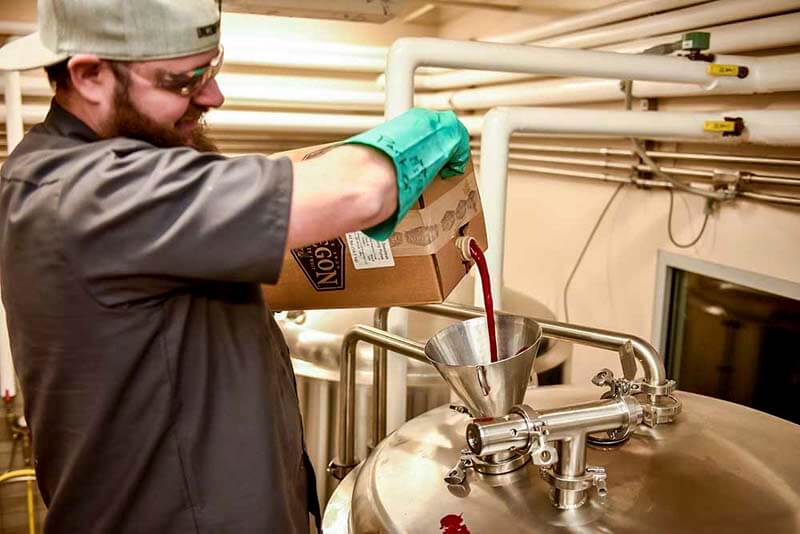
Photography courtesy of Oregon Fruit Products
Real fruit, like any commodity, is an ingredient whose price fluctuates based on market conditions, agricultural issues, climate change, and a host of other variables.
“Fruited beers are probably the most expensive beers you make,” says Dingham. “The fruit purees, they’re not cheap obviously, so you need to be cognizant of that and be cognizant of which fruits to use which year.”
Overall though, Hodge says that “fruit as a whole hasn’t necessarily become more expensive,” indicating that Oregon Fruit Products portfolio has remained fairly stable over the years.
What has changed is that “we’ve seen brewers running breweries like a real business,” he says. “All of a sudden people didn’t realize how much money they spent on fruit and they were only making a three percent margin on that beer they sold because of how much fruit they used.”
Instead, Hodge advocates that if you’re using fruit puree, take that as an opportunity to see where you can cut back in other areas of the recipe.
“The cost of fruit actually cuts down the cost of expensive hops,” says Hodge. “I always ask brewers: Hey, did you realize what’s your fruit bill? What’s your hop bill? What’s your grain bill? What are you looking for in terms of the buildout? What gravity do you want to hit? All those things combined—we can help them save money by saying you don’t need to add this amount of hops or grain if you’re dosing with fruit because it doesn’t do anything for the finished product.”
He continues, “The fact is you’re actually just throwing money away. There is a way to mitigate the cost of adding a ton of fruit by looking at your other ingredient costs.”
Plus, when it comes to deciding whether or not to use a fruit puree, the cost can often be a slippery slope for breweries.
“There is a temptation to reduce the cost of goods by using cheaper, less-quality products,” says Smith. “Do I switch to something with a lot of additives? Do I switch to something with a lesser shipping cost? When you start to go there it does start to affect the finished product and the claims you can make.”
You’ll need to decide for yourself whether all the benefits mentioned at the beginning of this guide make the juice worth the squeeze when it comes to cost.
What Are the Best Styles for Brewing With Fruit Puree?
Immediately sour beers come to mind when using fruit puree.
“One thing we learned and I personally love is that any type of sour beer—kettle sour or barrel sourced—whether using PDO, lacto, it doesn’t matter, it all really screams for fruit,” says Hodge.
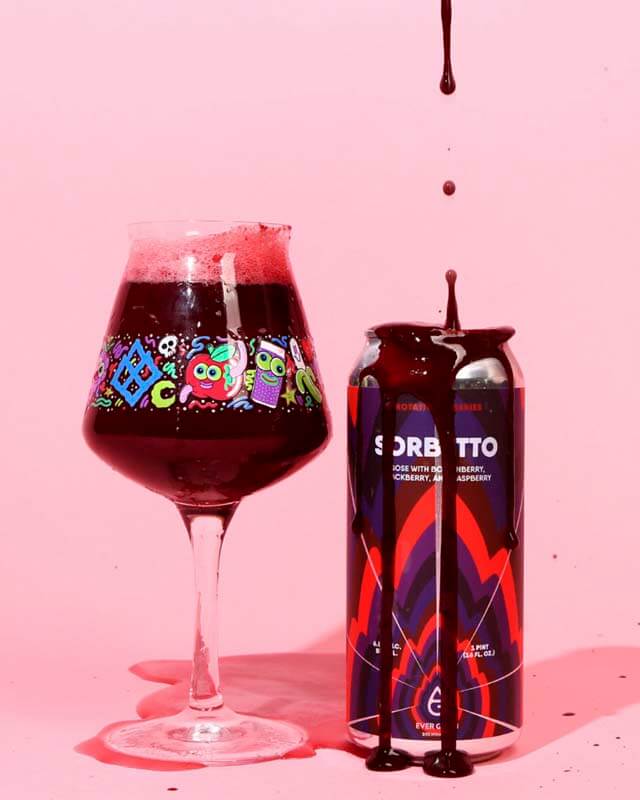
Photography courtesy of John A. Paradiso
Looking to give your consumers something they’ve never tasted before?
“The whole kettle sour is insanely popular for fruited anything,” says Hodge, noting that Berliner weisses and goses are popular categories for introducing fruit puree too. Hodge even suggests that since it’s currently wintertime in certain parts of the country, stouts or porters are great candidates for fruit purees like cherry or dark berries.
Basically, the spectrum of styles where you can include fruit puree are vast, from the lighter sour subcategories all the way over to the darker porter, stouts, and even barrel-aged beers.
A couple styles that Hodge says might be best to avoid? “I’m not a fan of the mid-range beers like ambers, reds, and browns,” he says. “I don’t find anything appealing [about] using fruit in those types of beers.”
Whatever style you choose, Dingham says just be cognizant of your end goal. What beer are you going for? What do you want the end style to taste like? “For our Daily Serving it is going to be a lot sweeter, a little more luscious in mouthfeel, so we’ll intentionally make sure the beer finishes higher in gravity to give it that extra sweetness and body.”
The Most Popular Fruit Puree Flavors (Plus, a Couple Hidden Gems)
If you’re new to the fruit-puree game, here are a few faithful flavors that are consistently on everyone’s radar.
At Oregon Fruit Products, the most popular fruit purees include: raspberry, mango, pineapple, passion fruit (“because it’s so intense,’ says Hodge), blueberry, and blackberry.
According to Hodge, raspberry has always been in the top three, but it took a serious hit this year during the caneberry crisis. “Good news is raspberry is such a universally popular and preferred fruit that it’s still in the top three,” he says. “Supply and demand has a real impact on how brewers move across the fruit spectrum; we’re seeing top performers remain that because they’re so popular, they’re known entities.”
Like at Trillium, where Dingham immediately calls out raspberry as one of his favorite fruit purees to use for a variety of reasons.
First, the puree is “more fresh, more intensity of fruit than if you eat fresh raspberries,” he says. But also because “raspberries hold up well compared to other fruits.”
You’ll find raspberry puree across a variety of Trillium’s Daily Servings iterations. But most telling, Dingham says, “it’s one of the few fruits that has a stand along Daily Serving just because it has so much character that it can hold up everything on its own.”
You’ll also find Daily Serving flavors with a myriad of raspberry combinations, including raspberry, strawberry, blueberry, cranberry, and blackberry, to name a few.
A few other noteworthy fruit purees include the citrus category, especially grapefruit, which according to Hodge is experiencing “a resurgence and renewed interest.”
Also key lime and lemon have “seen a nice lift over the course of the last three years,” according to Hodge because folks are using those flavors across a variety of beverages, including beer, hard seltzer, and Ready-to-Drink (RTD) beverages.
At Trillium, Dingham has been really impressed with calamansi, a type of Filipino lime that “smells like a really fresh mandarin orange with a really beautiful bright, citrus character.”
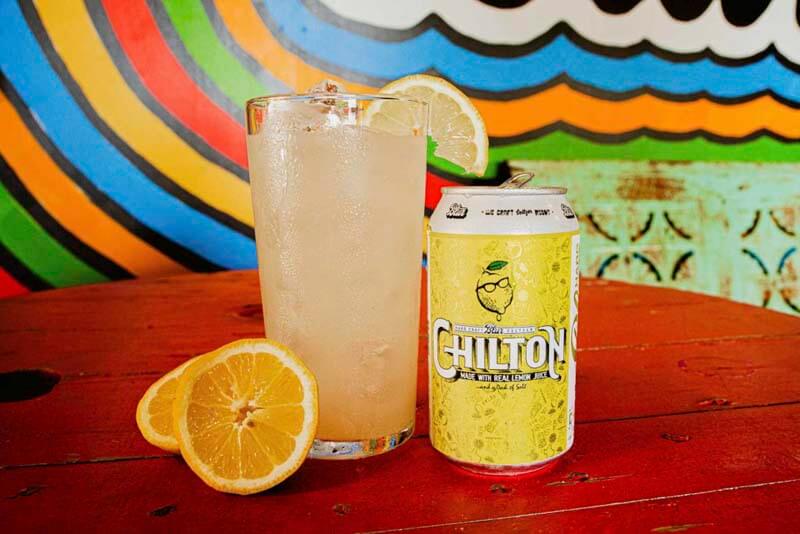
Photography courtesy of TUPPS Brewery
A Few Hidden Gems
Although the popular fruit purees are appealing, Hodge says brewers shouldn’t sleep on some real hidden-gem flavors.
Among those, dark sweet cherry, which scores a twenty-four on the brix scale, has a massive intensity of color and a very complex flavor profile.
Plum is another fruit puree Hodge says is “a great gem in our portfolio [because] it’s very affordable, has a super broad spectrum of flavors and profiles that can lift other fruits.”
The 3 Fruit Purees That Are Tough to Use in Brewing
Immediately strawberries came to Hodge’s mind. Contrary to the food industry, where strawberry ranks in the top three to five flavors across all products, in the brewing industry strawberry can be very challenging to use.
“It’s a very weak, delicate fruit that if not properly used can fade into nothingness,” says Hodge.
Also blood orange and pomegranate, Hodge says, can be difficult. “Those are susceptible [to oxidation] and very delicate, so if not used properly can fade away.”
If you do decide to go the route of strawberry, blood orange, or pomegranate, Smith recommends blending those fruit purees with some other fruits to really make them pop.
The 3 Best Tips for Working With Fruit Puree
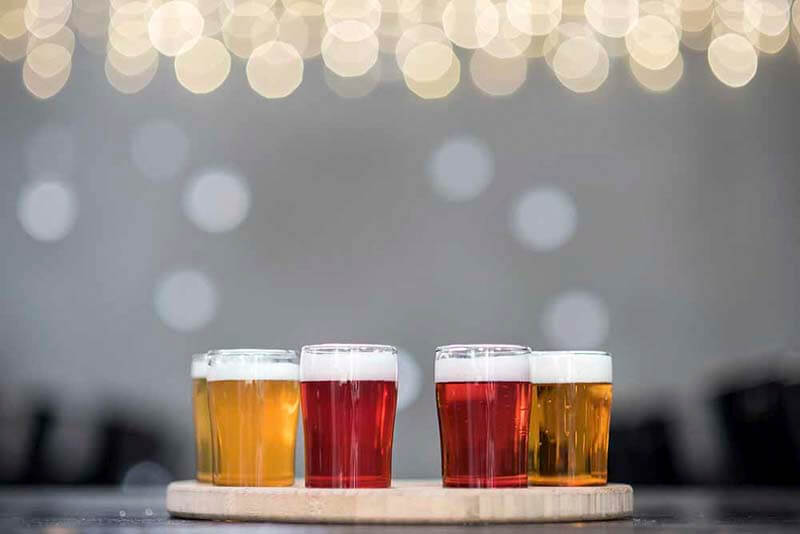
Photography courtesy of Aubrie LeGault | Oregon Fruit Products
Because the experts know best, we asked them to leave us with a few golden nuggets.
1. Test, Test, and Test Again
“What people don’t understand is that fruit isn’t just this thing you might [think you] understand because you once bit into pick a fruit,” says Hodge. “It might not have the same impact on the flavor of the finished beer. It’s really critical [to]…get samples into your hands and to your team.”
Dingham stresses this point as well. “Don’t leave fruit combinations to chance,” he says. Trillium benchtops all of their beers with fruit purees before scaling them up to bigger batches.
And that’s mostly thanks to taking advantage of samples.
Hodge says free samples are Oregon Fruit Products’ number-one tool. Take advantage of them, seriously.
2. Consider Some of Those Less Popular Fruit Puree Flavors
Remember those hidden-gem flavors Hodge suggested above? Leveraging those options can be more affordable and actually, when blended, lift up some of those more expensive fruit purees, meaning you can use less of them.
“We have all these less expensive fruits you can use to carry other fruits that might be more expensive,” he says. “There are some really cool ways to maximize those blends without bastardizing one fruit you want to focus on.”
3. Talk to the Experts
In many cases brewers may be hesitant to use fruit because, as we’ve covered in this piece, there are a lot of variables to consider: How do you use it? Where do you use it? How do you dose it? Is it going to cost you more?
Hopefully we covered a lot of those topics here, but if you still have questions, just ask!
“There is a need to come to experts, come to our team, and ask the questions and try to figure out success before investment,” says Smith. “There are a lot of smart pivots to be made. We’re happy to have those relationships and a team to help brewers figure out how to be better than their competitors.”
Talk to the experts, who have been handling fruit purees for literally decades, to get all the answers you need.
“Take a little advice,” says Hodge. “People don’t need to fear the fruit!”
The Future of Fruit Purees
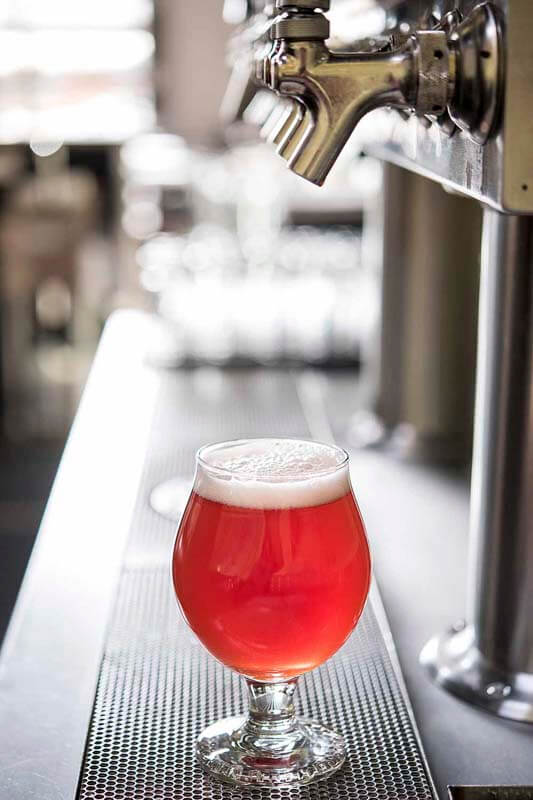
Photography courtesy of Aubrie LeGault | Oregon Fruit Products
Hodge says that “the future for fruit is incredibly bright.”
He goes on to explain that, while there are cost considerations when using the real thing, there is “generally speaking nothing but upside for real fruit and for the end customer because they want it.”
More than ever now, we’re seeing that in taprooms across the country. “The taprooms are where we see fruit really having a big, bright future,” says Hodge. “Every single brewer I’m talking to is investing in their taproom, opening a second taproom. They’re realizing the taproom is where home runs come on a daily basis…and that’s where fruity can really drive those local people to come into their taproom more than once a week.”
Using real fruit puree differentiates you from the crowd, opening your business up to a cornucopia of new beers to build.
“Make it fun and weird and try stuff,” says Smith.
Ready to Brew Your Best Beer? Try Ollie!
Ollie is brewery management software built by brewers, for brewers. Ollie enables breweries to better manage brewery production, customer relationships, order processing, inventory, payments, and reporting in a single platform.
Ready to give it a try? Contact our team today and set up a free demo!



